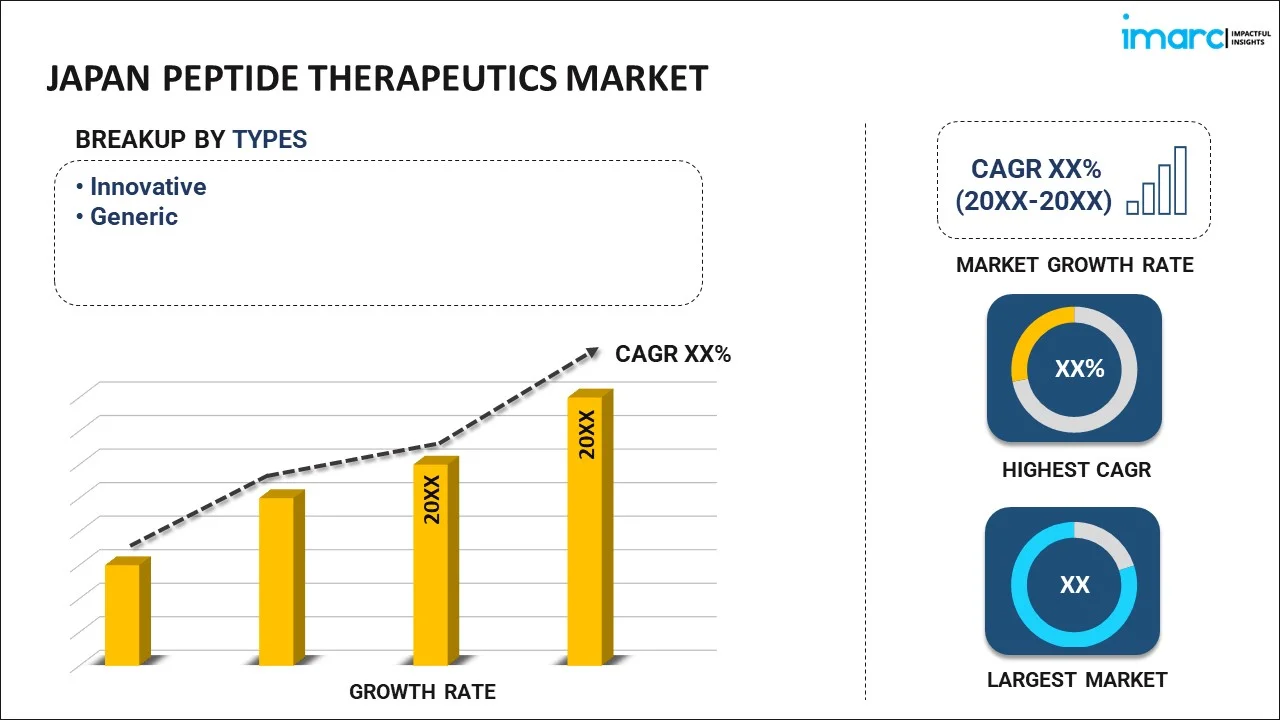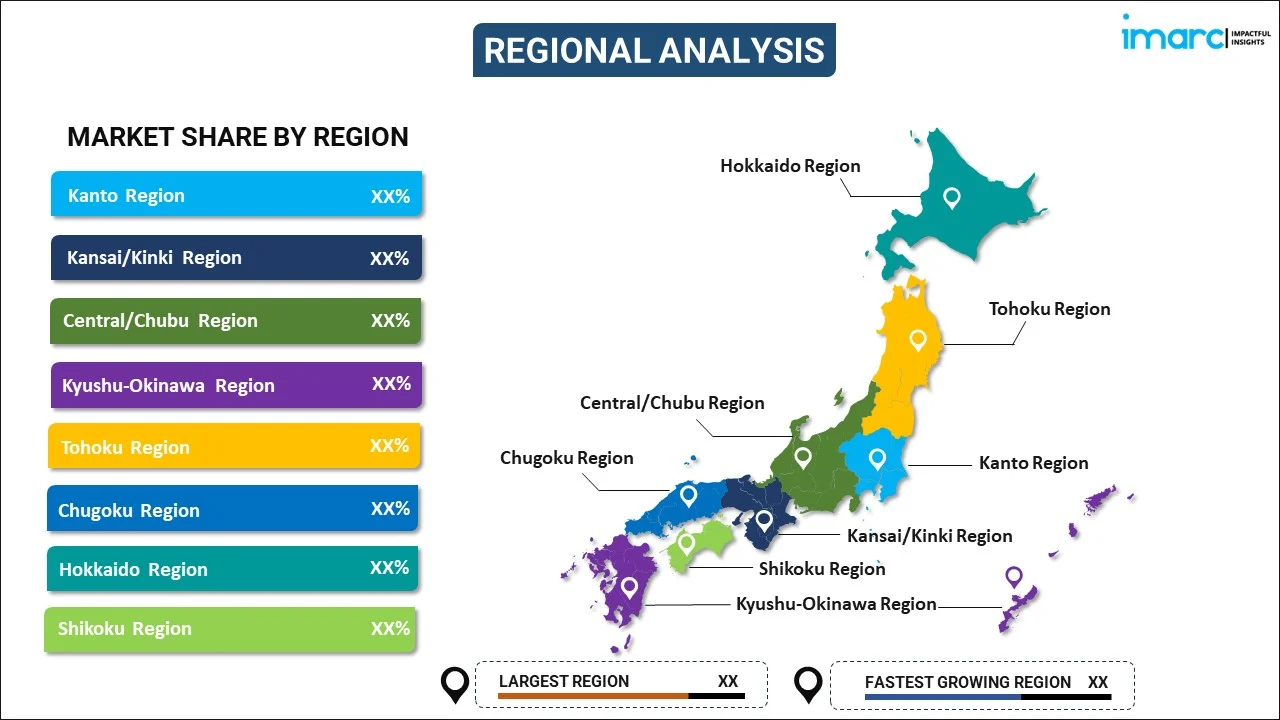
Japan Peptide Therapeutics Market Report by Type (Innovative, Generic), Types of Manufacturer (Outsourced, In-house), Synthesis Technology (Solid Phase Peptide Synthesis, Liquid Phase Peptide Synthesis, Hybrid Technology), Routes of Administration (Parenteral, Oral, and Others), Application (Gastrointestinal Disorders, Neurological Disorders, Metabolic Disorders, Cancer, and Others), and Region 2025-2033
Market Overview:
Japan peptide therapeutics market size reached USD 2,592.7 Million in 2024. Looking forward, IMARC Group expects the market to reach USD 4,776.2 Million by 2033, exhibiting a growth rate (CAGR) of 6.37% during 2025-2033. The inflating need for fast and precise treatment methods to cure diabetes, along with the increasing inclination among individuals towards cosmetic procedures to mitigate the effects of skin aging, is primarily driving the market growth.
|
Report Attribute
|
Key Statistics
|
|---|---|
|
Base Year
|
2024 |
|
Forecast Years
|
2025-2033 |
|
Historical Years
|
2019-2024
|
| Market Size in 2024 | USD 2,592.7 Million |
| Market Forecast in 2033 | USD 4,776.2 Million |
| Market Growth Rate (2025-2033) | 6.37% |
Peptides are highly effective and specific signaling molecules that attach to particular cell surface receptors, including ion channels and G protein-coupled receptors (GPCRs), initiating intracellular responses. In the pharmaceutical sector, they are utilized to develop innovative regenerative therapies capable of targeting various types of cells and influencing their reactions. These therapies, in comparison to other treatment alternatives, are less toxic, generally safe, and well-tolerated. Consequently, they are becoming increasingly popular in clinical applications throughout Japan for the treatment of conditions such as cancer, injuries, infectious diseases, metabolic disorders, and aesthetic concerns.
Japan Peptide Therapeutics Market Trends:
The increasing prevalence of both acute and chronic illnesses, alongside improved access to medical services, stands as a prominent factor that is positively impacting the demand for peptides in the development of innovative therapies, which is primarily driving the market growth. Additionally, peptides are employed in cosmeceutical procedures to mitigate the effects of skin aging. This, combined with the growing awareness among individuals about their physical appearance and the desire to maintain youthful and healthy skin, is propelling the adoption of cosmetic treatments and peptide-based therapeutics worldwide. Furthermore, the introduction of new synthetic techniques that reduce the frequency of injections and enhance the stability and other physical attributes of peptide therapeutics has led to their widespread use in injections for diabetic patients. This, in conjunction with the increasing incidence of diabetes and a preference for rapid and precise treatment methods , is driving the utilization of peptide therapeutics over oral medications. Moreover, the emerging trend of personalized and targeted therapies is driving the demand for versatile peptide-based materials, which is acting as another significant growth-inducing factor. Alongside this, the growing investment in the development of novel peptide therapeutics for autoimmune and inflammatory conditions is expected to create a favorable market outlook in the coming years.
Japan Peptide Therapeutics Market Segmentation:
IMARC Group provides an analysis of the key trends in each segment of the market, along with forecasts at the country level for 2025-2033. Our report has categorized the market based on type, type of manufacturer, synthesis technology, routes of administration, and application.
Type Insights:

- Innovative
- Generic
The report has provided a detailed breakup and analysis of the market based on the type. This includes innovative and generic.
Type of Manufacturer Insights:
- Outsourced
- In-house
A detailed breakup and analysis of the market based on the type of manufacturer have also been provided in the report. This includes outsourced and in-house.
Synthesis Technology Insights:
- Solid Phase Peptide Synthesis
- Liquid Phase Peptide Synthesis
- Hybrid Technology
The report has provided a detailed breakup and analysis of the market based on the synthesis technology. This includes solid phase peptide synthesis, liquid phase peptide synthesis, and hybrid technology.
Routes of Administration Insights:
- Parenteral
- Oral
- Others
A detailed breakup and analysis of the market based on the routes of administration have also been provided in the report. This includes parenteral, oral, and others.
Application Insights:
- Gastrointestinal Disorders
- Neurological Disorders
- Metabolic Disorders
- Cancer
- Others
The report has provided a detailed breakup and analysis of the market based on the application. This includes gastrointestinal disorders, neurological disorders, metabolic disorders, cancer, and others.
Regional Insights:

- Kanto Region
- Kansai/Kinki Region
- Central/ Chubu Region
- Kyushu-Okinawa Region
- Tohoku Region
- Chugoku Region
- Hokkaido Region
- Shikoku Region
The report has also provided a comprehensive analysis of all the major regional markets, which include Kanto Region, Kansai/Kinki Region, Central/ Chubu Region, Kyushu-Okinawa Region, Tohoku Region, Chugoku Region, Hokkaido Region, and Shikoku Region.
Competitive Landscape:
The market research report has also provided a comprehensive analysis of the competitive landscape. Competitive analysis such as market structure, key player positioning, top winning strategies, competitive dashboard, and company evaluation quadrant has been covered in the report. Also, detailed profiles of all major companies have been provided.
Japan Peptide Therapeutics Market Report Coverage:
| Report Features | Details |
|---|---|
| Base Year of the Analysis | 2024 |
| Historical Period | 2019-2024 |
| Forecast Period | 2025-2033 |
| Units | Million USD |
| Scope of the Report | Exploration of Historical and Forecast Trends, Industry Catalysts and Challenges, Segment-Wise Historical and Predictive Market Assessment:
|
| Types Covered | Innovative, Generic |
| Types of Manufacturers Covered | Outsourced, In-house |
| Synthesis Technologies Covered | Solid Phase Peptide Synthesis, Liquid Phase Peptide Synthesis, Hybrid Technology |
| Routes of Administrations Covered | Parenteral, Oral, Others |
| Applications Covered | Gastrointestinal Disorders, Neurological Disorders, Metabolic Disorders, Cancer, Others |
| Regions Covered | Kanto Region, Kansai/Kinki Region, Central/ Chubu Region, Kyushu-Okinawa Region, Tohoku Region, Chugoku Region, Hokkaido Region, Shikoku Region |
| Customization Scope | 10% Free Customization |
| Post-Sale Analyst Support | 10-12 Weeks |
| Delivery Format | PDF and Excel through Email (We can also provide the editable version of the report in PPT/Word format on special request) |
Key Questions Answered in This Report:
- How has the Japan peptide therapeutics market performed so far and how will it perform in the coming years?
- What has been the impact of COVID-19 on the Japan peptide therapeutics market?
- What is the breakup of the Japan peptide therapeutics market on the basis of type?
- What is the breakup of the Japan peptide therapeutics market on the basis of type of manufacturer?
- What is the breakup of the Japan peptide therapeutics market on the basis of synthesis technology?
- What is the breakup of the Japan peptide therapeutics market on the basis of routes of administration?
- What is the breakup of the Japan peptide therapeutics market on the basis of application?
- What are the various stages in the value chain of the Japan peptide therapeutics market?
- What are the key driving factors and challenges in the Japan peptide therapeutics?
- What is the structure of the Japan peptide therapeutics market and who are the key players?
- What is the degree of competition in the Japan peptide therapeutics market?
Key Benefits for Stakeholders:
- IMARC’s industry report offers a comprehensive quantitative analysis of various market segments, historical and current market trends, market forecasts, and dynamics of the Japan peptide therapeutics market from 2019-2033.
- The research report provides the latest information on the market drivers, challenges, and opportunities in the Japan peptide therapeutics market.
- Porter's five forces analysis assist stakeholders in assessing the impact of new entrants, competitive rivalry, supplier power, buyer power, and the threat of substitution. It helps stakeholders to analyze the level of competition within the Japan peptide therapeutics industry and its attractiveness.
- Competitive landscape allows stakeholders to understand their competitive environment and provides an insight into the current positions of key players in the market.
Need more help?
- Speak to our experienced analysts for insights on the current market scenarios.
- Include additional segments and countries to customize the report as per your requirement.
- Gain an unparalleled competitive advantage in your domain by understanding how to utilize the report and positively impacting your operations and revenue.
- For further assistance, please connect with our analysts.
 Inquire Before Buying
Inquire Before Buying
 Speak to an Analyst
Speak to an Analyst
 Request Brochure
Request Brochure
 Request Customization
Request Customization




.webp)




.webp)












